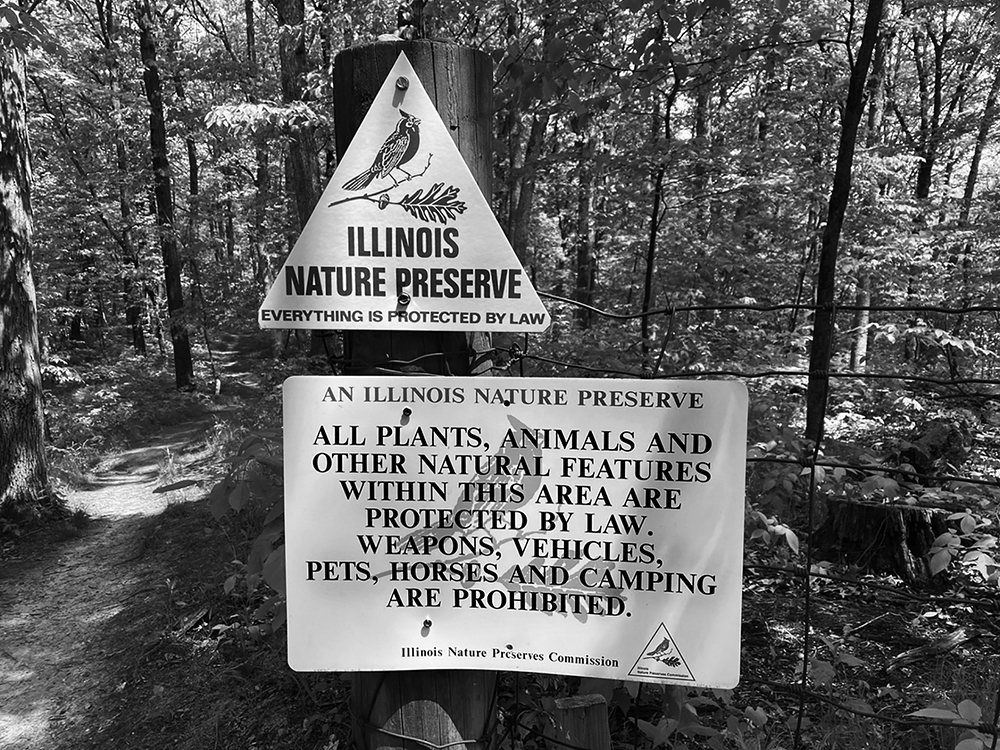
MIKE MILLER

Illinois Nature Preserves Commission sign on entry to Singing Woods Nature Preserve from Tawny Oaks, 715 W. Singing Woods Road, Edelstein. (PHOTO BY MIKE MILLER)
Nature Preserves are truly the “last of the best” natural areas left in the Land of Lincoln. Over 50 years ago, the Illinois Natural History Survey did an inventory of the remaining natural areas within the state of Illinois. Those that were of the highest quality were included in what would be known as the Illinois Natural Areas Inventory (INAI). What they found was that less than 0.1% of Illinois was in a pristine condition. In other words, human activity in the last 250 years has altered over 99.9% of the state. With so few pristine natural areas remaining, the State of Illinois set out to develop a method of preserving the few that remained. In 1963, the Illinois Nature Preserves Commission (INPC) was established with the goal of protecting as many of the remaining high-quality natural areas that were identified in the INAI as they could.
Not just any area can be an Illinois Nature Preserve. It is a rather exclusive club. The site has to be an intact ecosystem that contains rare species of plants and animals and has not been severely degraded by the influences of humans. Since its inception in 1963, the INPC has permanently protected over 600 sites, encompassing over 115,000 acres. It is a purely voluntary program to become a Nature Preserve. If the landowner agrees, and the site meets the qualifications, the state will place a permanent conservation easement on the property that ensures that the site can never be developed for anything other than the protection of its natural features. It is a huge commitment for a landowner to forever agree to the protection of a property. They have given up their right to develop it, and the protection remains intact even if the property changes ownership. It is also one of the greatest legacies that anyone can leave for future generations.
One thing that the recent pandemic has made evident is that people from all walks of life have found a renewed awareness of the natural world. More people are out on trails and walking by the triangular nature preserve signs than ever before. In Central Illinois, the Peoria Park District has four nature preserves: Forest Park, Detweiller Woods, Robinson Park Hill Prairies and Singing Woods. The Fon du Lac Park District has two: Bennett’s Terraqueous Gardens and Fon du Lac Seep. There are a few other nature preserves being protected by private landowners, and land trusts as well.
If you are wandering into a natural area and see the nature preserve sign, you are entering a realm somewhat untouched by time. So few places remain in such a pristine condition in Illinois. Take a moment and give thanks to the people who protected the site. In many ways, you are entering a cathedral. It is a place dedicated to the plants and animals that live there, but it is also a place where we can find our inner peace, and get to understand our place in the natural world. Happy hiking!
To find out more about the Illinois Nature Preserves System, and to locate nature preserves in your area, visit the website: https://www2.illinois.gov/dnr/INPC/Pages/default.aspx.

2 comments for “Nature Rambles | Why Nature Preserves?”